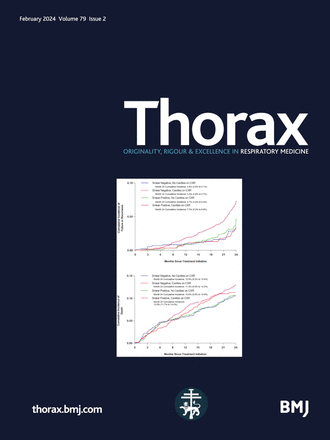PM2.5 as a risk factor for sleep oxygen desaturation in COPD: identifying susceptible individuals by smoking and inflammatory phenotypes
IF 9
1区 医学
Q1 RESPIRATORY SYSTEM
引用次数: 0
Abstract
Background Nocturnal hypoxia is prevalent in chronic obstructive pulmonary disease (COPD) and contributes significantly to poor disease prognosis. However, its key environmental risk factors and susceptible phenotypes remain poorly understood. Methods This prospective repeated-measure study included 96 patients with COPD with real-time personal monitoring of fine particulate matter (PM2.5) and oxygen saturation (SpO2) during sleep (84 971 observations), aiming to investigate the association of PM2.5 with oxygen desaturation and identify susceptible individuals by smoking and inflammatory phenotypes. Inflammatory phenotypes were determined by exhaled biomarkers (nitric oxide and hydrogen sulfide) and blood leucocytes (neutrophils and eosinophils). Generalised linear mixed models were applied to estimate the risk of oxygen desaturation associated with PM2.5. Results Personal PM2.5 exposure was significantly associated with sleep SpO2 decline within hours. The highest risk of oxygen desaturation associated with PM2.5 was observed in current smokers (OR=1.53, 95% CI: 1.22 to 1.92), followed by former smokers (OR=1.14, 95% CI: 1.02 to 1.28), with no significant effect in never smokers. Notably, current smokers exhibited higher neutrophilic inflammation, and those with higher airway neutrophilic inflammation were more susceptible to PM2.5-related oxygen desaturation (p interaction<0.001). For former smokers, those with higher small-airway eosinophilic inflammation were more susceptible (p interaction <0.001). Both former and current smokers with a systemic mixed granulocyte phenotype were at greater risk of oxygen desaturation. Furthermore, individuals with constant high inflammation are more susceptible to PM2.5-related oxygen desaturation than those without inflammation. Conclusions Airborne PM2.5 is an important risk factor for sleep hypoxia in patients with COPD, especially for individuals with smoking history and specific inflammatory phenotypes. Trial registration number [NCT05076630][1]. Data are available upon reasonable request. [1]: /lookup/external-ref?link_type=CLINTRIALGOV&access_num=NCT05076630&atom=%2Fthoraxjnl%2Fearly%2F2025%2F06%2F20%2Fthorax-2025-223140.atomPM2.5是COPD患者睡眠氧饱和度降低的危险因素:通过吸烟和炎症表型识别易感个体
背景:夜间缺氧在慢性阻塞性肺疾病(COPD)中很普遍,是导致疾病预后不良的重要因素。然而,其关键的环境风险因素和易感表型仍然知之甚少。方法本前瞻性重复测量研究纳入96例COPD患者,实时监测睡眠期间细颗粒物(PM2.5)和血氧饱和度(SpO2)(84 971例观察),旨在探讨PM2.5与血氧饱和度的关系,并通过吸烟和炎症表型识别易感个体。通过呼出的生物标志物(一氧化氮和硫化氢)和血液白细胞(中性粒细胞和嗜酸性粒细胞)来确定炎症表型。应用广义线性混合模型来估计与PM2.5相关的氧去饱和风险。结果个人PM2.5暴露与睡眠时间内SpO2下降显著相关。在当前吸烟者中观察到与PM2.5相关的氧去饱和风险最高(OR=1.53, 95% CI: 1.22至1.92),其次是前吸烟者(OR=1.14, 95% CI: 1.02至1.28),对从不吸烟者无显著影响。值得注意的是,当前吸烟者表现出较高的中性粒细胞炎症,而气道中性粒细胞炎症较高的人更容易发生pm2.5相关的氧去饱和(p相互作用<0.001)。对于前吸烟者,小气道嗜酸性粒细胞炎症较高的患者更容易感染(p相互作用<0.001)。无论是以前的吸烟者还是现在的吸烟者,其全身混合粒细胞表型都有更高的氧去饱和风险。此外,持续高炎症的个体比没有炎症的个体更容易发生与pm2.5相关的氧饱和度降低。结论空气中PM2.5是COPD患者睡眠缺氧的重要危险因素,特别是对有吸烟史和特定炎症表型的个体。试验注册号[NCT05076630][1]。如有合理要求,可提供资料。[1]: /查找/ external-ref ? link_type = CLINTRIALGOV&access_num = NCT05076630&atom = % 2 fthoraxjnl % 2恐惧% 2 f2025 % 2 f06 % 2 f20 % 2 fthorax - 2025 - 223140. -原子
本文章由计算机程序翻译,如有差异,请以英文原文为准。
求助全文
约1分钟内获得全文
求助全文
来源期刊

Thorax
医学-呼吸系统
CiteScore
16.10
自引率
2.00%
发文量
197
审稿时长
1 months
期刊介绍:
Thorax stands as one of the premier respiratory medicine journals globally, featuring clinical and experimental research articles spanning respiratory medicine, pediatrics, immunology, pharmacology, pathology, and surgery. The journal's mission is to publish noteworthy advancements in scientific understanding that are poised to influence clinical practice significantly. This encompasses articles delving into basic and translational mechanisms applicable to clinical material, covering areas such as cell and molecular biology, genetics, epidemiology, and immunology.
 求助内容:
求助内容: 应助结果提醒方式:
应助结果提醒方式:


